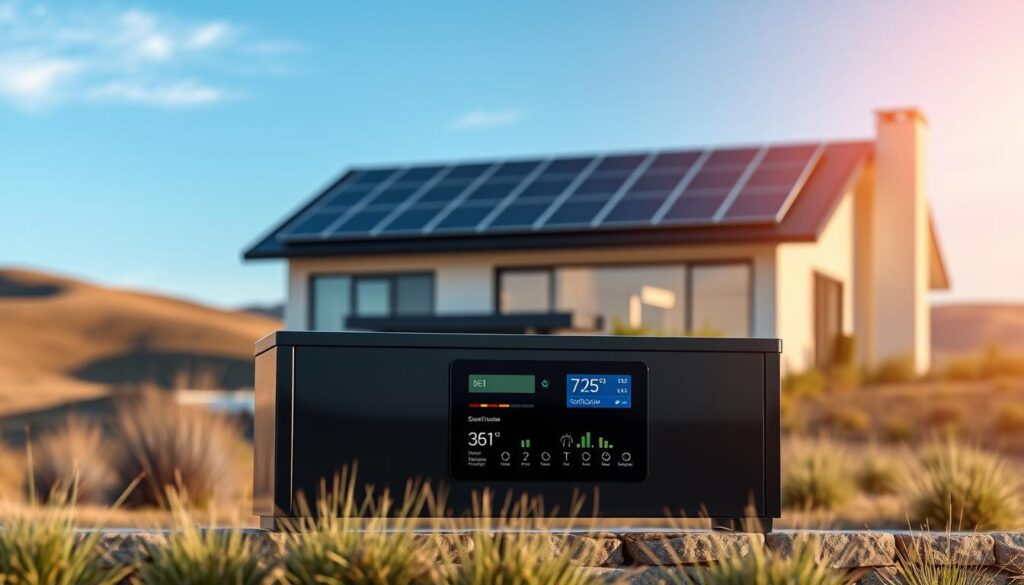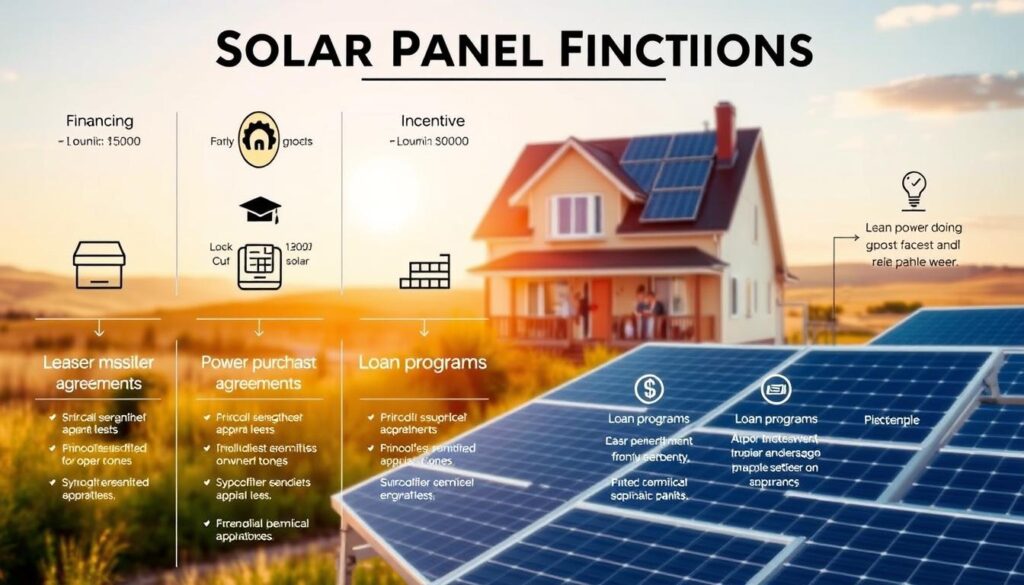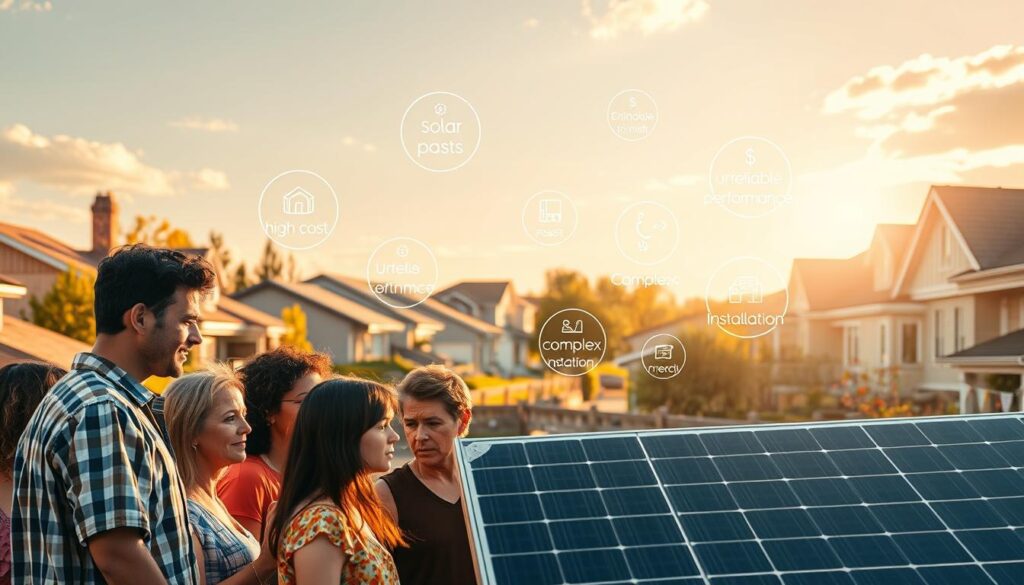More Americans are turning to solar panels to power their lives. These systems capture sunlight and convert it into clean, renewable energy. With nearly 4 million households already using this option, it’s clear that solar energy is reshaping how we think about electricity.
One of the biggest advantages is the potential for significant savings. By reducing reliance on traditional utility grids, homeowners can cut their electricity bills by up to 90%. Additionally, federal and state incentives make the initial investment more affordable, with tax credits covering a portion of the cost.
Modern advancements have also improved panel designs and storage solutions. Innovations like lithium-ion batteries ensure energy is available even when the sun isn’t shining. This combination of savings, efficiency, and environmental benefits makes solar energy a smart choice for many.
Key Takeaways
- Solar panels convert sunlight into clean, renewable energy.
- Homeowners can save up to 90% on electricity bills.
- Federal and state incentives reduce installation costs.
- Modern designs and batteries improve energy storage.
- Solar systems increase property value and reduce carbon footprints.
Introduction to the Ultimate Guide on Home Solar Technology
Solar energy is transforming how U.S. households manage their power needs. This guide will walk you through everything you need to know about adopting this clean energy solution. From understanding the basics to exploring financial incentives, we’ve got you covered.
Overview of Solar Energy Advantages
Switching to solar power offers numerous benefits. First, it significantly reduces electricity bills. Many homeowners save thousands of dollars over the lifespan of their system. Second, it’s an environmentally friendly choice, reducing reliance on fossil fuels and lowering carbon footprints.
Technological advancements have made panels more efficient and affordable. Modern systems include advanced batteries that store excess energy for later use. This ensures a reliable power supply, even during cloudy days or at night.
Importance for U.S. Homeowners
For Americans, solar energy is more than just a trend—it’s a practical solution to rising energy costs. With the average monthly electricity bill projected to reach $144 in 2025, many are looking for ways to cut expenses. Solar systems can eliminate or drastically reduce these costs.
Government incentives, like the federal tax credit, make the initial investment more manageable. Programs like net metering allow homeowners to earn credits for excess energy sent back to the grid. These factors make solar power an attractive option for those looking to save money and contribute to a greener future.
How Solar Panels Capture the Sun’s Energy
Understanding how sunlight is converted into usable power is key to appreciating solar panels. These systems rely on advanced components and innovative designs to generate electricity efficiently. Let’s break down the process and explore the latest advancements in this field.
Basic Components and Operation
At the heart of every solar panel are photovoltaic (PV) cells. These cells are made from semiconductor materials, usually silicon, which absorb sunlight and release electrons. This creates an electric current that is then converted into usable electricity.
The process begins when sunlight hits the panel. The PV cells absorb the light, causing electrons to move and generate direct current (DC) electricity. An inverter then converts this DC electricity into alternating current (AC), which powers homes and businesses.
Key components include:
- PV Cells: Convert sunlight into electricity.
- Inverter: Transforms DC into AC power.
- Mounting System: Secures panels to rooftops or ground installations.
- Battery Storage: Stores excess energy for later use.
Innovative Designs and Materials
Recent advancements have introduced new materials and designs that enhance efficiency. For example, perovskite is a promising material that can be used to create lightweight, flexible panels. These panels are easier to install and can be used in a variety of settings.
Another innovation is the bifacial panel, which captures sunlight on both sides. This design increases energy generation by up to 30% compared to traditional panels. Flexible panels, on the other hand, are ideal for curved surfaces or portable applications.
| Panel Type | Efficiency | Cost | Best Use |
|---|---|---|---|
| Monocrystalline | High | Expensive | Residential rooftops |
| Polycrystalline | Moderate | Affordable | Budget-friendly projects |
| Thin-Film | Low | Cheapest | Large-scale installations |
| Bifacial | Very High | Moderate | Commercial and industrial |
These innovations not only improve performance but also reduce costs, making solar energy more accessible. By understanding these components and designs, homeowners can make informed decisions about their energy needs.
Environmental and Economic Benefits
Reducing environmental impact while saving money is now easier than ever. Solar systems offer a unique combination of sustainability and financial rewards. By harnessing the sun’s energy, these systems provide clean power while lowering utility bills and increasing property value.

Reducing Your Carbon Footprint
Switching to renewable energy significantly cuts carbon emissions. Traditional power sources like coal and oil release harmful pollutants, contributing to climate change. Solar panels, on the other hand, generate electricity without emitting greenhouse gases.
According to recent studies, a typical residential system can offset 3 to 4 tons of carbon dioxide annually. Over its lifetime, this reduction is equivalent to planting hundreds of trees. By reducing reliance on fossil fuels, solar energy helps preserve ecosystems and improve air quality.
Long-Term Savings and Increased Home Value
Investing in solar panels is not just good for the planet—it’s great for your wallet too. Homeowners can save up to 90% on electricity bills over the system’s lifespan. Many states also offer incentives like tax credits and net metering programs, making the initial cost more manageable.
Additionally, properties with solar installations often see a 4-6% increase in market value. Buyers are increasingly drawn to homes with lower energy costs and eco-friendly features. This makes solar systems a smart financial decision for both current and future homeowners.
“Solar energy is a win-win solution—protecting the environment while boosting your bottom line.”
By combining environmental sustainability with long-term savings, solar systems provide a compelling option for those looking to make a positive impact. Whether you’re motivated by financial gains or ecological responsibility, the benefits are clear.
Advancements in Solar Energy Efficiency and Performance
The evolution of solar panels has reached new heights with cutting-edge materials and designs. These innovations are not only improving efficiency but also making systems more adaptable and cost-effective. Let’s explore the latest breakthroughs that are shaping the future of renewable energy.
New Materials and Multi-Junction Cells
One of the most exciting developments is the use of perovskite in multi-junction cells. This material has shown remarkable potential, achieving efficiency rates of up to 33% in recent tests. Unlike traditional silicon-based cells, perovskite is lightweight and flexible, making it ideal for diverse applications.
Multi-junction cells take this a step further by layering multiple materials to capture a broader spectrum of sunlight. This approach significantly boosts energy conversion rates, pushing the boundaries of what’s possible in solar technology.
Bifacial and Flexible Panel Innovations
Another game-changer is the rise of bifacial panels. These designs capture sunlight on both sides, increasing energy production by up to 30%. Homeowners report noticeable gains during morning and evening hours, making this a smart choice for maximizing output.
Flexible panels are also gaining traction. Made from thin-film materials, they can be installed on curved surfaces or portable setups. This versatility opens up new possibilities for installations in unconventional spaces.
“These advancements are not just about efficiency—they’re about making solar energy accessible and practical for everyone.”
These innovations are driving down costs while improving performance. For example, installation expenses have dropped by over 70% since 2010, thanks to streamlined designs and new mounting systems. Homeowners can now enjoy higher efficiency and durability without breaking the bank.
- Perovskite and multi-junction cells boost efficiency to 33%.
- Bifacial panels increase energy production by up to 30%.
- Flexible designs adapt to curved surfaces and portable setups.
- Cost reductions make installations more affordable than ever.
As you evaluate your options, consider how these advancements can enhance your system’s performance and savings. The future of solar energy is here, and it’s brighter than ever.
Energy Storage and Smart Integration with Solar Systems
Energy storage is revolutionizing how we use renewable power. Modern batteries and smart panels are making systems more efficient and reliable. These advancements ensure that excess energy is stored and used effectively, even when the sun isn’t shining.

Modern Battery Technologies
Batteries play a crucial role in storing excess energy generated by panels. Lithium-ion systems are the most common, offering high efficiency and long lifespans. However, emerging alternatives like zinc-based and thermal storage are gaining traction for their unique advantages.
Zinc-based batteries are cost-effective and environmentally friendly. Thermal storage, on the other hand, uses heat to generate electricity, making it ideal for large-scale applications. These options provide flexibility and enhance the overall performance of energy systems.
Smart Panels and Interactive Features
Smart panels are transforming how we manage power. These systems use digital technology to optimize energy distribution and storage. Features like remote monitoring and automated load management allow homeowners to control their usage efficiently.
For example, during peak demand, smart panels can switch between solar, battery, and grid power seamlessly. This not only reduces costs but also ensures a reliable energy supply during outages. Such integration supports grid resilience and energy independence.
“Smart energy management systems are the future of renewable power, offering both savings and sustainability.”
By combining advanced batteries with smart features, these systems provide a more reliable and cost-effective solution. Whether you’re looking to save money or reduce your environmental impact, these innovations make renewable energy a practical choice.
The Solar Panel Installation Process Explained
Installing solar panels is a straightforward process that begins with a detailed site assessment. This ensures your property is suitable for generating clean energy. From planning to powering up, every step is designed to maximize efficiency and savings.
Site Assessment and Planning
The first step is a professional evaluation of your property. Experts assess your roof’s condition, angle, and orientation to determine the best setup. They also check your electrical system to ensure compatibility with the new panels.
Key factors include:
- Roof Condition: Ensuring it can support the weight of the panels.
- Sunlight Exposure: Identifying areas with maximum sunlight.
- Electrical Capacity: Verifying your system can handle the additional load.
Once the assessment is complete, a customized plan is created. This includes the number of panels, their placement, and the estimated energy output.
Installation Steps and Utility Interconnection
The actual installation typically takes one to three days. It involves mounting the panels, wiring them to your electrical system, and connecting to the grid. Here’s a breakdown of the process:
- Mounting: Panels are securely attached to your roof or ground-mounted system.
- Wiring: Panels are connected to an inverter, which converts DC electricity to AC.
- Meter Update: Your utility company installs a new meter to track energy production.
After installation, the utility company conducts an inspection and issues Permission to Operate (PTO). This allows your system to start generating electricity.
“A seamless installation process ensures your solar panels are up and running quickly, delivering immediate benefits.”
| Step | Description | Duration |
|---|---|---|
| Site Assessment | Evaluate roof, sunlight, and electrical system | 1-2 days |
| Installation | Mount panels, wire system, update meter | 1-3 days |
| Utility Inspection | Verify compliance and issue PTO | 1-2 weeks |
By following these steps, you can enjoy the benefits of clean energy with minimal hassle. Proper planning and professional installation ensure your system operates efficiently for years to come.
Evaluating Costs, Incentives, and Financing Options
Investing in renewable energy solutions can seem daunting, but understanding the costs and incentives makes it easier. While the initial expense may appear high, numerous programs and financing options can significantly reduce the burden. Let’s explore how you can make this transition affordable and rewarding.

Understanding Initial Investment and Incentives
The average cost of installing a residential solar panel system is around $25,000. However, federal and state incentives can lower this amount. For example, the federal Investment Tax Credit allows you to deduct 30% of the installation cost from your taxes. Many states also offer additional rebates and programs to further reduce expenses.
Over the past decade, the cost of solar energy systems has dropped by over 70%. This, combined with rising electricity prices, makes the investment more appealing. Homeowners can save up to 90% on their utility bills over the system’s lifespan, making it a financially sound decision.
Solar Loans, Leases, and Purchase Options
There are several ways to finance your panel installation. Outright purchases provide the highest long-term savings, as you avoid interest charges and monthly payments. However, if upfront costs are a concern, solar loans and leases offer flexibility.
Loans typically have annual percentage rates (APRs) ranging from 1% to 7%, with terms of 8 to 25 years. Leases, on the other hand, require no down payment and allow you to pay a fixed monthly fee. Both options make it easier to adopt renewable energy without a large initial investment.
“Choosing the right financing option depends on your financial goals and current situation. Each model has its own advantages and drawbacks.”
To make the best decision, compare quotes from multiple providers and consider your long-term savings. Whether you opt for a cash purchase, loan, or lease, the benefits of clean energy and reduced utility bills are within reach.
Overcoming Common Myths and Considerations for Homeowners
Many homeowners hesitate to adopt solar panels due to common misconceptions. These myths often overshadow the real benefits of renewable energy. Let’s address these concerns and provide clarity to help you make an informed decision.

Debunking Misconceptions on Solar Efficiency
One of the most persistent myths is that panels only work in sunny climates. While sunlight is essential, modern systems are designed to generate electricity even on cloudy days. In fact, panels can still produce up to 25% of their maximum output in overcast conditions.
Another misconception is that panels require constant maintenance. In reality, they only need occasional cleaning with water and a soft sponge. Most systems are built to withstand harsh weather, ensuring durability for decades.
“Modern solar panels are highly efficient and require minimal upkeep, making them a practical choice for any homeowner.”
Assessing Roof Suitability and Local Policies
Before installation, it’s important to evaluate your roof’s suitability. Factors like orientation, angle, and shading can impact performance. South-facing roofs with a 30-degree angle are ideal for maximizing sunlight exposure.
Local policies and homeowner association guidelines also play a role. Some areas offer incentives like tax credits or net metering programs, while others may have restrictions. Consulting with certified installers can help navigate these regulations and ensure compliance.
- Roof Condition: Ensure it can support the weight of the panels.
- Sunlight Exposure: Identify areas with maximum sunlight.
- Local Policies: Check for incentives or restrictions in your area.
By addressing these considerations, you can confidently move forward with your solar investment. With the right information and professional guidance, the benefits of clean energy are within reach.
Home Solar Technology: Choosing the Best System for Your Home
Selecting the right solar panel system for your home requires careful consideration of several factors. From efficiency to financing, each detail plays a role in ensuring you get the most out of your investment. This guide will help you navigate the process with ease.
Factors to Consider When Comparing Options
When evaluating different systems, start by assessing their efficiency. High-efficiency panels generate more electricity, which can lead to greater savings over time. Look for panels with a minimum efficiency rating of 20% for optimal performance.
Design is another critical factor. Monocrystalline panels are known for their sleek appearance and high efficiency, while polycrystalline options are more budget-friendly. Thin-film panels, though less efficient, are lightweight and versatile.
Financing options also vary. Outright purchases offer the highest long-term savings, but loans and leases provide flexibility for those who prefer lower upfront costs. Consider your financial goals when choosing a payment plan.
| Feature | Monocrystalline | Polycrystalline | Thin-Film |
|---|---|---|---|
| Efficiency | High | Moderate | Low |
| Cost | Expensive | Affordable | Cheapest |
| Best Use | Residential | Budget Projects | Large-Scale |
Tips for a Hassle-Free Selection Process
Start by obtaining multiple quotes from reputable providers. This allows you to compare costs and features, ensuring you get the best deal. Verify certifications and customer reviews to confirm the company’s reliability.
Long-term savings should be a priority. While the initial cost may seem high, systems with higher efficiency and durability often pay for themselves over time. Look for warranties that guarantee performance for at least 25 years.
Finally, consider post-installation support. Reliable companies offer maintenance services and assistance with utility interconnections. This ensures your system operates smoothly for years to come.
“Choosing the right solar panel system is an investment in both your finances and the environment.”
By following these tips, you can confidently select a system that meets your needs and maximizes your savings. With the right information and professional guidance, the benefits of clean energy are within reach.
Conclusion
Adopting clean energy systems offers both financial and environmental rewards. From reducing monthly bills to lowering carbon footprints, the benefits are clear. Modern advancements in panel designs and battery storage make these systems more reliable and efficient than ever.
Financing options like loans and tax credits have made the initial investment more accessible. Programs like net metering allow homeowners to earn credits for excess electricity, further enhancing savings. These innovations ensure that renewable power is a practical choice for many.
As you explore your options, use this guide as a resource to make informed decisions. Reach out to certified advisors for tailored advice. The future of energy is bright, and embracing these solutions benefits both you and the planet.
